

The man behind the Google brain: Andrew Ng and the quest for the new AI. Artificial intelligence (credit: Alejandro Zorrilal Cruz/Wikimedia Commons) There’s a theory that human intelligence stems from a single algorithm.
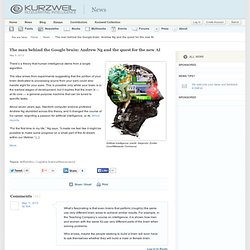
The idea arises from experiments suggesting that the portion of your brain dedicated to processing sound from your ears could also handle sight for your eyes. Using large-scale brain simulations for machine learning and A.I. You probably use machine learning technology dozens of times a day without knowing it—it’s a way of training computers on real-world data, and it enables high-quality speech recognition, practical computer vision, email spam blocking and even self-driving cars.

But it’s far from perfect—you’ve probably chuckled at poorly transcribed text, a bad translation or a misidentified image. We believe machine learning could be far more accurate, and that smarter computers could make everyday tasks much easier. So our research team has been working on some new approaches to large-scale machine learning. Today’s machine learning technology takes significant work to adapt to new uses. For example, say we’re trying to build a system that can distinguish between pictures of cars and motorcycles. Fortunately, recent research on self-taught learning (PDF) and deep learning suggests we might be able to rely instead on unlabeled data—such as random images fetched off the web or out of YouTube videos. Google Hires Brains that Helped Supercharge Machine Learning.
Geoffrey Hinton (right) Alex Krizhevsky, and Ilya Sutskever (left) will do machine learning work at Google.

Photo: U of T Google has hired the man who showed how to make computers learn much like the human brain. His name is Geoffrey Hinton, and on Tuesday, Google said that it had hired him along with two of his University of Toronto graduate students — Alex Krizhevsky and Ilya Sutskever. Their job: to help Google make sense of the growing mountains of data it is indexing and to improve products that already use machine learning — products such as Android voice search. Google paid an undisclosed sum to buy Hinton’s company, DNNresearch. 'Chinese Google' Opens Artificial-Intelligence Lab in Silicon Valley.
Kai Yu, of the Chinese search giant Baidu, discusses “deep learning” inside the company’s new Silicon Valley outpost.

Photo: Alex Washburn / Wired It doesn’t look like much. The brick office building sits next to a strip mall in Cupertino, California, about an hour south of San Francisco, and if you walk inside, you’ll find a California state flag and a cardboard cutout of R2-D2 and plenty of Christmas decorations — even though we’re well into April. But there are big plans for this building. The Man Behind the Google Brain: Andrew Ng and the Quest for the New AI. There’s a theory that human intelligence stems from a single algorithm.
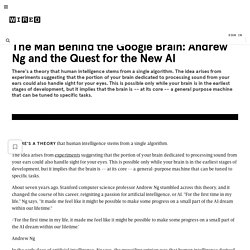
The idea arises from experiments suggesting that the portion of your brain dedicated to processing sound from your ears could also handle sight for your eyes. This is possible only while your brain is in the earliest stages of development, but it implies that the brain is — at its core — a general-purpose machine that can be tuned to specific tasks. About seven years ago, Stanford computer science professor Andrew Ng stumbled across this theory, and it changed the course of his career, reigniting a passion for artificial intelligence, or AI. Network of brain cells models smart power grid. A network of hundreds or thousands of dissociated mammalian cortical cells (neurons and glia) are cultured on a transparent multi-electrode array.
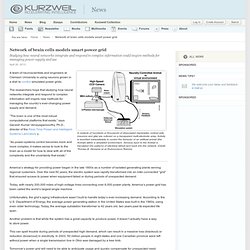
Activity is recorded extracellularly to control the behavior of an artificial animal (the Animat) within a simulated environment. Sensory input to the Animat is translated into patterns of electrical stimuli sent back into the network. (Credit: Thomas B. Demarse et al. /Autonomous Robots) A team of neuroscientists and engineers at Clemson University is using neurons grown in a dish to control simulated power grids. The researchers hope that studying how neural networks integrate and respond to complex information will inspire new methods for managing the country’s ever-changing power supply and demand.
Frequently Asked Questions. NeuroSolutions Frequently Asked Questions (FAQ) Questions about the Technology What is a neural network?

What kind of real-world problems can neural networks solve? What are genetic algorithms? How can genetic algorithms be used to improve neural networks? Nanowire-memristor networks emulate brain functions. Image of a nanowire network (credit: CRANN) A Trinity College Dublin chemistry professor has been awarded a €2.5 million ($3.2 million) research grant by the European Research Council (ERC) to continue research into nanowire networks.
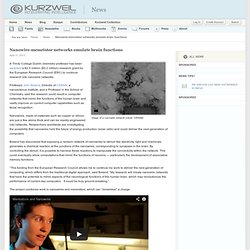
Professor John Boland, Director of CRANN, a nanoscience institute, and a Professor in the School of Chemistry, said the research could result in computer networks that mimic the functions of the human brain and vastly improve on current computer capabilities such as facial recognition. Nanowires, made of materials such as copper or silicon, are just a few atoms thick and can be readily engineered into networks. Canadian scientists create a functioning, virtual brain. Chris Eliasmith has spent years contemplating how to build a brain.

He is about to publish a book with instructions, which describes the grey matter’s architecture and how the different components interact. So Eliasmith’s team built Spaun, which was billed Thursday as “the world’s largest simulation of a functioning brain.” Spaun can recognize numbers, remember lists and write them down. It even passes some basic aspects of an IQ test, the team reports in the journal Science. Several labs are working on large models of the brain– including the multi-million-dollar Blue Brain Project in Europe – but these can’t see, remember or control limbs, says Eliasmith. “Right now very large-scale models of the brain don’t do anything,” he said in an interview. His Waterloo team took a different approach, using computers to simulate what goes on inside the brain, similar to the way aircraft simulators mimic flight. Is it time to move past the idea that our brain is like a computer?
Is it time to move past the idea that analogies are perfect?
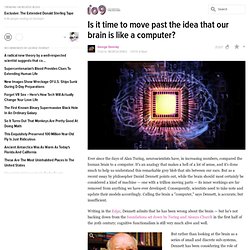
No, it's not. Because nobody except insufferable pedants treat analogies like they're somehow either perfect or irredeemably broken. The brain is like a computer in many ways. It's not exactly like a computer, but it is like one. It processes inputs and produces outputs in a way that nothing we have now except a computer system even comes close to. There are ways that computers and brains are different. Introducing Spaun — the world's largest functioning model of the human brain. Spaun, the new human brain simulator, can carry out tasks (w/ video)
(Phys.org)—One of the challenges of understanding the complex behavior of animals is to relate the behavior to the complex processes occurring within the brain. So far, neural models have not been able to bridge this gap, but a new software model, Spaun, goes some way to addressing this problem. The Semantic Pointer Architecture Unified Network (Spaun) is a computer model of the human brain built by Professor Chris Eliasmith and colleagues of the University of Waterloo in Canada.
It comprises around two and a half million virtual neurons organized into functional groups rather like real neurons in regions of the human brain associated with vision, short-term memory, and so on. Scientists Create Artificial Brain With 2.3 Million Simulated Neurons. Scientists Create Artificial Brain With 2.3 Million Simulated Neurons Another computer is setting its wits to perform human tasks.
But this computer is different. The Most Realistic Artificial Brain Has a Mind of Its Own. SPREAD SPECTRUM BASED STATISTICALLY DISTRIBUTED - 1209.4855.pdf. ‘Rain Man’-like brains mapped with network analysis. The 3D structural connectome of seven adults without a corpus callosum, a top genetic cause of autism. The larger, redder circles represent the hubs of the whole-brain network — the regions with the greatest number of connections to other regions.
(Credit: Julia P. Owen et al.) Researchers at UC San Francisco and UC Berkeley have mapped the three-dimensional global connections within the brains of seven adults who have genetic malformations that leave them without the corpus callosum, which connects the left and right sides of the brain. These “structural connectome” maps, which combine hospital MRIs with the mathematical tool known as network analysis, reveal new details about the condition known as agenesis of the corpus callosum, one of the top genetic causes of autism. Understanding how brain connectivity varies from person to person may help researchers identify imaging biomarkers for autism to help diagnose it and manage care for individuals.